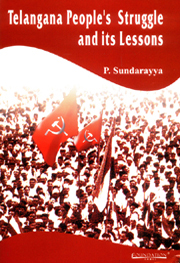Book contents
- Frontmatter
- Contents
- Preface
- Introduction
- PART I
- PART II
- 1 Entry of Indian Army and Immediately After
- 2 Terror Regime and Resistance
- 3 The Krishna Forest (Nallamala) Region
- 4 The Godavari Forest Region
- 5 Actions of Guerrilla Squads
- 6 People's Upsurge in Karimnagar and other New Areas
- 7 Movement in Cities and of the Working Class
- 8 Struggle Inside Jails
- 9 Women in the Telangana Movement
- 10 Brief Sketches of Some of the Squad and Party Leaders: after the Entry of the Indian Army
- 11 Withdrawal of Telangana Armed Partisan Resistance
- Epilogue
- PART III
8 - Struggle Inside Jails
from PART II
Published online by Cambridge University Press: 05 November 2011
- Frontmatter
- Contents
- Preface
- Introduction
- PART I
- PART II
- 1 Entry of Indian Army and Immediately After
- 2 Terror Regime and Resistance
- 3 The Krishna Forest (Nallamala) Region
- 4 The Godavari Forest Region
- 5 Actions of Guerrilla Squads
- 6 People's Upsurge in Karimnagar and other New Areas
- 7 Movement in Cities and of the Working Class
- 8 Struggle Inside Jails
- 9 Women in the Telangana Movement
- 10 Brief Sketches of Some of the Squad and Party Leaders: after the Entry of the Indian Army
- 11 Withdrawal of Telangana Armed Partisan Resistance
- Epilogue
- PART III
Summary
The struggle conducted inside the jails during the period of the Telangana struggle was indeed historic and was a part and parcel of the struggle outside. If only 12,000 were arrested during the struggle against the Nizam, as many as 50,000 were arrested during the military regime of the Union Government.
The space in sub-jails, district jails and central jails was not enough, despite the fact that the jails were over-crowded to six times their capacity. For instance, as many as 900 prisoners were kept in the Nalgonda jail, the capacity of which was not more than 100. So in places like Khammam, they put up electrified barbed wire fences in open places and kept thousands of Communists and other Telangana fighters thus enclosed. Special regiments were kept in charge of the jail establishment, which the authorities themselves nicknamed as the ‘Khammam Cage’.
They were not ordinary jails; people were herded into them like cattle and sheep and men did not get facilities which even cattle got from their owners. They were not mere jails; they were concentration and torture camps.
The jail manuals of the feudal regime had no place for political prisoners. The military regime was much worse in that regard. There was no difference between those who were brought to jail and not yet convicted and those who were convicted. As such, prisoners had to fight for their honour and dignity as politicals.
Khammam Concentration Camp
After filling the ordinary jails beyond their capacity, they herded into the “Khammam Cage” about 2,000 prisoners. They put up tents which did not give protection either from the sun or from rain. The prisoners were victims of both.
- Type
- Chapter
- Information
- Telengana People's Struggle and it's Lessons , pp. 234 - 245Publisher: Foundation BooksPrint publication year: 2006

